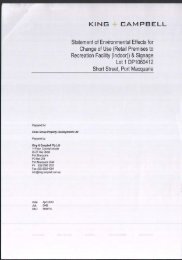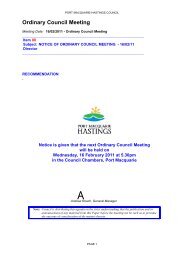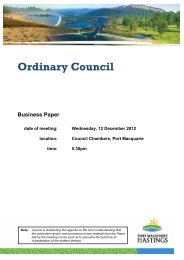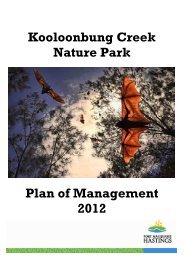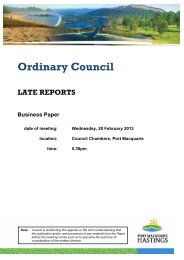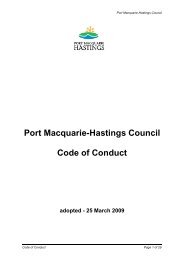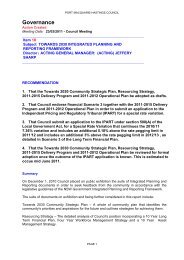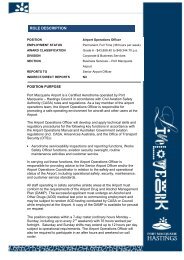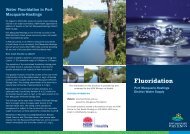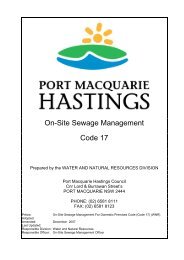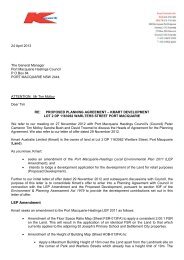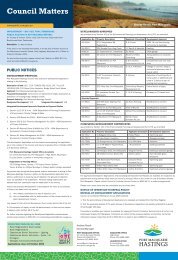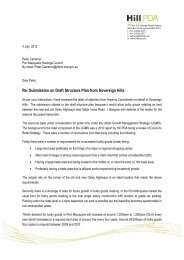Lake Cathie Coastal Hazard Study Appendix D - Hastings Council
Lake Cathie Coastal Hazard Study Appendix D - Hastings Council
Lake Cathie Coastal Hazard Study Appendix D - Hastings Council
Create successful ePaper yourself
Turn your PDF publications into a flip-book with our unique Google optimized e-Paper software.
3 Comparison with Previous Assessments<br />
3.1 Introduction<br />
Previous assessments of photogrammetric data at and around <strong>Lake</strong> <strong>Cathie</strong> have been<br />
carried out by NSW Public Works (1990, 1991). These assessments were purely an<br />
analysis of photogrammetric data, at Bonny Hills (south of Middle Rock) and <strong>Lake</strong> <strong>Cathie</strong><br />
(NSW Public Works, 1990); and at northern Lighthouse Beach (NSW Public Works,<br />
1991).<br />
The Bonny Hills – <strong>Lake</strong> <strong>Cathie</strong> assessment identified long term recession from 1940 to<br />
1988 on a profile-by-profile basis, and found average long term recession rates north of<br />
Middle Rock of around 0.1 – 0.2 m/year. It also found accelerated long term recession of<br />
around 0.3 m/year occurring immediately offshore of Illaroo Road and adjacent to the<br />
<strong>Lake</strong> <strong>Cathie</strong> entrance. This assessment also identified the dumping of rock adjacent to the<br />
southern end of the entrance which may have masked the longer-term recessional trend<br />
for this area. No short-term storm erosion demand values are estimated.<br />
The northern Lighthouse Beach assessment (NSW Public Works, 1991) showed that at<br />
the northern end of the beach (outside the study area), there was no clear trend of long<br />
term erosion or accretion of the dune, though there were localised recession rates of up to<br />
0.3 m/year at individual locations. The frontal dune along parts of north Lighthouse Beach<br />
was subject to sand mining in the late 1950’s and early 1960’s and it is commented that<br />
this may have impacted the results.<br />
The NSW Public Works (1991) assessment assumed a design storm erosion demand<br />
figure of 200 m 3 /m, based on data from other open coast beaches throughout NSW. That<br />
study also noted that there was considerable dune instability due to blow-outs and that a<br />
site specific assessment of storm erosion demand could not be made, due to the fact that<br />
the photographic records for the study area did not adequately capture the effects of<br />
severe storm events. It assumed a long-term recession rate of 0.25m/year, based on a<br />
general recession of the back-dune escarpment by around 11m.<br />
3.2 Storm Erosion<br />
This assessment found a design storm erosion volume for <strong>Lake</strong> <strong>Cathie</strong> of around<br />
130 m 3 /m from photogrammetric data. This value is less than the 200 m 3 /m adopted for<br />
the northern end of Lighthouse Beach in NSW Public Works (1991), due primarily to the<br />
nature of the indurated coffee rock substratum which is more resistant to erosion than<br />
typical unconsolidated beach sands.<br />
3.3 Long Term Recession<br />
3.3.1 Historic Rates<br />
From this assessment, a conservative allowance has been made for historic long term<br />
recession for the beach of 0.2 m/year. This compares with the average rate of recession<br />
of 0.25m/year assessed for northern Lighthouse Beach (NSW Public Works, 1991), and is<br />
similar to the rate of long term recession measured for <strong>Lake</strong> <strong>Cathie</strong> between 1940 and<br />
9<br />
<strong>Lake</strong> <strong>Cathie</strong> <strong>Coastal</strong> Zone Management Plan: <strong>Coastal</strong> <strong>Hazard</strong> <strong>Study</strong> Report – <strong>Appendix</strong> D – November 2010



